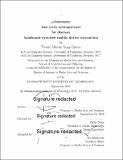| dc.contributor.author | Vega Gálvez, Tomás Alfonso. | en_US |
| dc.contributor.other | Program in Media Arts and Sciences (Massachusetts Institute of Technology) | en_US |
| dc.date.accessioned | 2024-04-10T21:40:43Z | |
| dc.date.available | 2024-04-10T21:40:43Z | |
| dc.date.copyright | 2019 | en_US |
| dc.date.issued | 2019 | en_US |
| dc.identifier.uri | https://hdl.handle.net/1721.1/154119 | |
| dc.description | Thesis: S.M., Massachusetts Institute of Technology, School of Architecture and Planning, Program in Media Arts and Sciences, 2019 | en_US |
| dc.description | [mu] appeared in title on title page appears as lower case Greek letter. Cataloged from the official PDF of thesis. | en_US |
| dc.description | Includes bibliographical references (pages 157-166). | en_US |
| dc.description.abstract | We often perform activities that situationally impair us, decreasing our ability to interact with mobile devices when needed. These impairments manifest physically, by preventing us from using our hands and eyes when already being devoted to other ongoing processes (i.e., biking, driving, etc), and socially, by making certain interaction modalities inappropriate given social norms, etiquette, and rules of engagement. Researchers have investigated using jaw and teeth microgestures as a discreet hands-and- eyes-free solution for mobile device interaction while situationally impaired. However, an opportunity remains to investigate ways to wirelessly and unobtrusively sense these gestures, and further explore and evaluate the design space for jaw and teeth microgestures in the context of general-purpose Human Computer Interaction. This thesis makes four major contributions to the exploration of jaw and teeth microgestures. Through an iterative prototyping process, the work contributes attachable, miniaturized, wireless sensor nodes that are placed bilaterally behind the ears to unobtrusively sense jaw-teeth microgestures with 88% accuracy in a stationary context. The thesis also presents a hyper-personalized mobile application that permits training jaw-teeth gestures and mapping them to mobile device commands. The work further contributes a universal teeth contact and jaw-teeth gesture taxonomy, which is evaluated for its comfort and usability. Finally, it contributes an exploration of the potential use cases of jaw-teeth-gesture-based mobile device interaction. | en_US |
| dc.description.statementofresponsibility | Tomás Alfonso Vega Gálvez. | en_US |
| dc.format.extent | 166 pages | en_US |
| dc.language.iso | eng | en_US |
| dc.publisher | Massachusetts Institute of Technology | en_US |
| dc.rights | MIT theses may be protected by copyright. Please reuse MIT thesis content according to the MIT Libraries Permissions Policy, which is available through the URL provided. | en_US |
| dc.rights.uri | http://dspace.mit.edu/handle/1721.1/7582 | en_US |
| dc.subject | Program in Media Arts and Sciences | en_US |
| dc.title | [mu]Jawstures : jaw-teeth microgestures for discreet hands-and-eyes-free mobile device interaction | en_US |
| dc.title.alternative | Jaw-teeth microgestures for discreet hands-and-eyes-free mobile device interaction | en_US |
| dc.type | Thesis | en_US |
| dc.description.degree | S.M. | en_US |
| dc.contributor.department | Program in Media Arts and Sciences (Massachusetts Institute of Technology) | en_US |
| dc.identifier.oclc | 1418760954 | en_US |
| dc.description.collection | S.M. Massachusetts Institute of Technology, School of Architecture and Planning, Program in Media Arts and Sciences | en_US |
| dspace.imported | 2024-04-10T21:40:42Z | en_US |
| mit.thesis.degree | Master | en_US |
